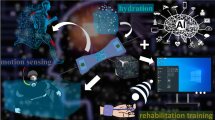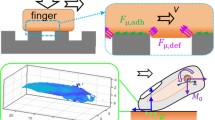Abstract
A modified adhesive peel test is described in which a spring is inserted between the test machine cross-head and the peeling strip. In tests using two pressure sensitive surgical adhesives (uncrosslinked elastomers) this “soft machine” gives results which differ significantly from those obtained with a conventional “hard machine”. In particular, when peeling energy is plotted against peeling velocity, the soft machine reveals a regime of low energy peeling and a transition to the normal high energy peeling. The transition behaviour has been studied as a function of adhesive thickness, cross-head speed and spring stiffness. The phenomena revealed by soft machine testing are interpreted in terms of variations in crack-tip radius caused by flow of the uncrosslinked rubber. The practical implication is that far more information can be obtained from soft machine tests than from conventional hard machine tests. The problem of oscillating peel force is also eliminated.
Similar content being viewed by others
References
J. J. Bikerman, “The Science of Adhesive Joints”, 2nd Edn. (Academic Press, New York, 1968).
A. N. Gent andG. R. Hamed,Polym. Eng. Sci. 17 (1977) 462.
J. O. Hendricks andC. A. Dahlquist, “Adhesion and Adhesives”, Vol. 2, edited by R. Hovwink and G. Salomon (Elsevier, Amsterdam, 1967).
A. J. Duke,J. Appl. Polym. Sci. 18 (1974) 3019.
D. H. Kaelble, “Physical Chemistry of Adhesion”, edited by D. H. Kaelble (Wiley International, 1979).
D. Satas, “Handbook of Pressure Sensitive Adhesive Technology”, edited by D. Satas (Van Nostrand Reinhold, New York, 1982).
E. H. Andrews andA. J. Kinloch,Proc. R. Soc. A. 332 (1973) 385.
A. N. Gent andJ. Schultz,J. Adhesion 3 (1972) 281.
K. Kendal,J. Phys. D. Appl. Phys. 4 (1971) 1186.
D. Maugis andM. Barquins,ibid. 11 (1978) 1989.
M. Barquins,Int. J. Adhesion Adhesives 3 (1983) 71.
A. N. Gent andA. J. Kinloch,J. Polym. Sci. A2 9 (1971) 659.
E. H. Andrews,J. Mater. Sci. 9 (1974) 887.
A. Ahagon andA. N. Gent,J. Polym. Sci. Polym. Phys. Ed. 13 (1975) 1285.
G. J. Lake andA. Stevenson, “Adhesion 6”, edited by K. W. Allen (Applied Science, Barking, 1982) p. 41.
G. J. Lake andA. G. Thomas,Proc. R. Soc. A 300 (1967) 108.
N. E. King andE. H. Andrews,J. Mater. Sci. 13 (1978) 1291.
G. J. Lake andP. B. Lindley,J. Appl. Polym. Sci. 9 (1965) 1233.
D. H. Kaelble,Trans. Soc. Rheol. 4 (1960) 45.
A. N. Gent andR. Petrich,Proc. R. Soc. A 310 (1969) 433.
D. W. Aubrey, “Developments in Adhesives I”, edited by W. C. Wake (Applied Science, arking, 1977) p. 127.
D. Satas andR. Mihalik,J. Appl. Polym. Sci. 12 (1968) 2371.
W. Döll, L. Könczöl andM. G. Schinker,Polymer 24 (1983) 1213.
A. G. Thomas,J. Polym. Sci. 18 (1955) 177.
Author information
Authors and Affiliations
Rights and permissions
About this article
Cite this article
Andrews, E.H., Khan, T.A. & Majid, H.A. Adhesion to skin. J Mater Sci 20, 3621–3630 (1985). https://doi.org/10.1007/BF01113769
Received:
Accepted:
Issue Date:
DOI: https://doi.org/10.1007/BF01113769




